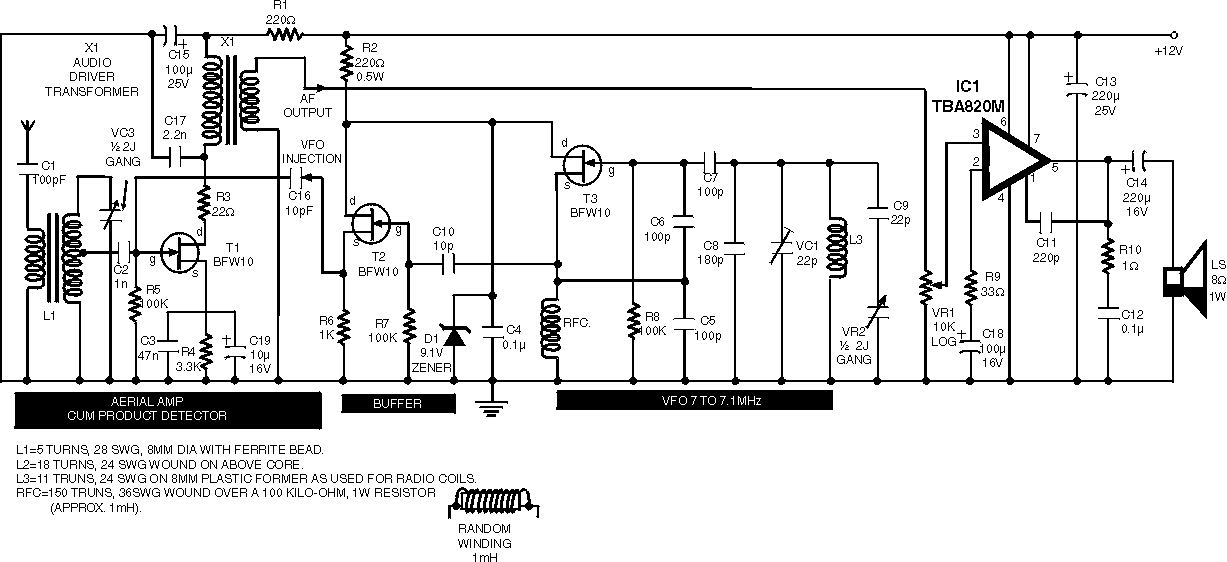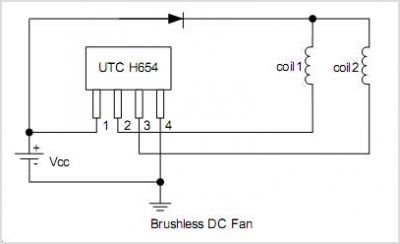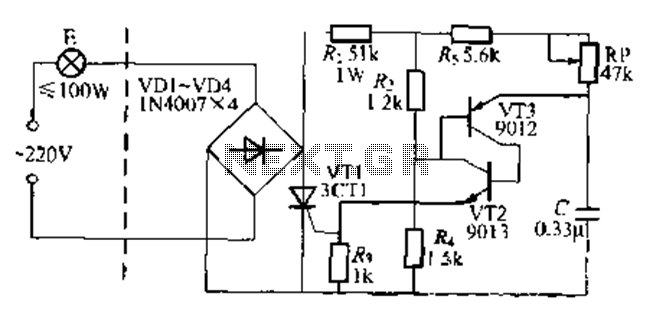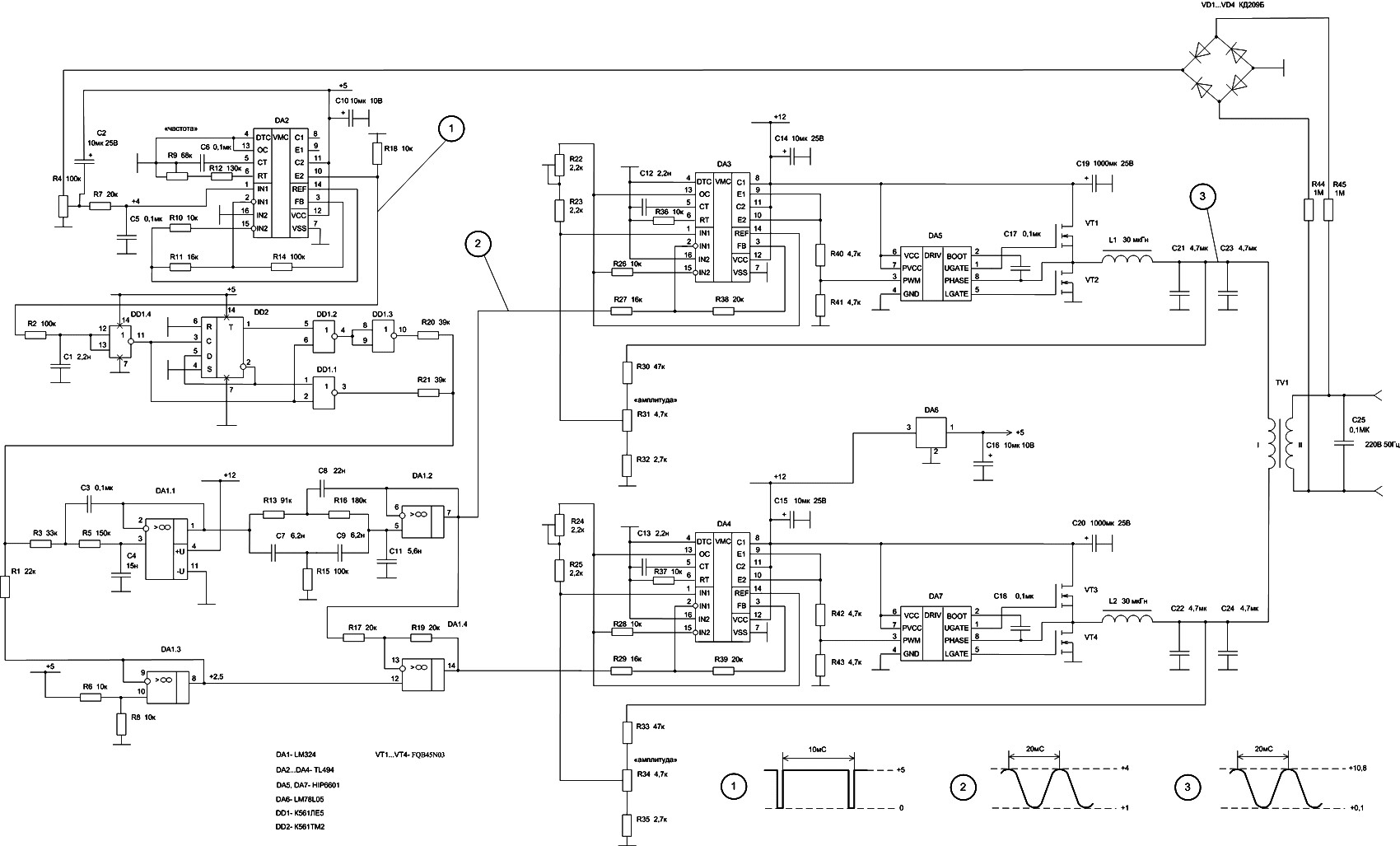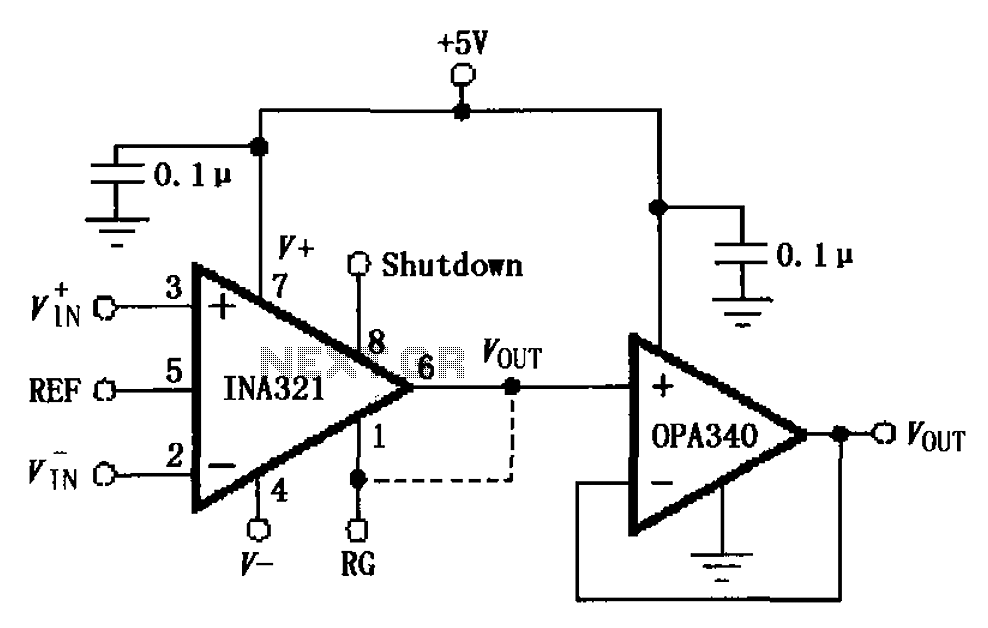
Implementation of Direct Output Buffers
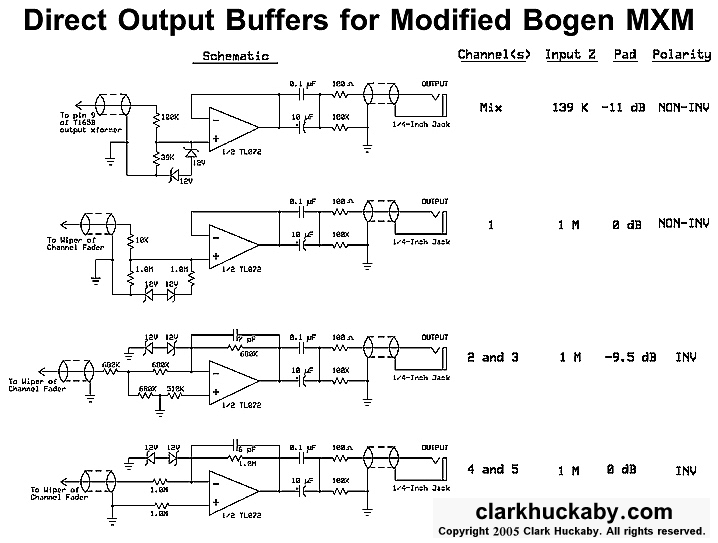
A total of six buffer circuits utilizing three dual op-amp packages are implemented, with five designated for input channels and one for the master output channel. These circuits feature high input impedance, particularly for the five buffers interfacing with channel faders, and low output impedance (less than 600 ohms), ensuring stability when driving shielded cables of moderate length. The design incorporates op-amps characterized by low noise and distortion, alongside low-noise metal film resistors throughout the circuit. The nominal audio output levels are compatible with current standards for ground-referenced audio lines, specifically -10 dBV, as exemplified by the unbalanced inputs of the Alesis ADAT recorder. The circuits maintain unity voltage gain, with voltage divider pads on inputs where necessary. Solid-state devices are designed to be immune to damage from excessive input voltages, and consistent signal polarity is preserved from inputs to outputs. All buffers are compactly arranged to fit on a perf-board measuring 2.3 x 3.7 inches, positioned above the chassis plane in a space previously occupied by two filter capacitor cans. For polarity consistency, all microphone inputs adhere to the standard where XLR pin 2 is designated as "hot" or positive, with XLR pin 3 as the inverse; the signal polarity on the tip contact of the 1/4-inch jack matches that of pin 2 on the input XLR. The Channel 1 preamp features two stages of triode amplification and operates as a non-inverting amplifier, while the other input channels function as inverting stages using single pentodes. Consequently, a non-inverting output buffer design is employed for Channel 1, and an inverting design for Channels 2 through 5. In relation to the mix bus, the master channel operates as an inverting amplifier, compensating for the inversion introduced by the majority of input channels, thus a non-inverting buffer is selected to drive the mix output jack. The output buffers utilize TL072 op-amps and share a common capacitor-coupled output design, incorporating a 10-microfarad electrolytic capacitor bypassed with a 0.1-microfarad stacked polypropylene film capacitor. This configuration is believed to enhance the performance of electrolytics in passing high frequencies and transients, contributing to sound clarity. Series 100-ohm resistors are included to ensure stable operation into shielded cables, particularly when interfacing with high-impedance inputs such as guitar amplifiers. The 100K resistors further enhance stability by providing a grounding pathway for all outputs. Input protection for the op-amps is achieved using opposing 12-V zener diodes, safeguarding against instantaneous signal voltages exceeding +/- 12 V, which offers a significant safety margin given the +/- 15V operational range of the chips. This overvoltage protection limits the maximum undistorted output of all six buffers to 18.6 dBV (24 Vp-p). For the master and Channel 1 output buffers, the op-amps are configured as unity-gain non-inverting voltage followers. In the master channel, a voltage divider formed by 100K and 39K resistors implements an 11-dB pad, establishing an input impedance of 139 K-ohm, which is lower than that of the other buffers, each having an input impedance of 1 M-ohm.
The schematic design comprises six buffer circuits that ensure optimal signal integrity and compatibility with modern audio equipment. Each buffer circuit is meticulously crafted to provide high input impedance, which is essential for maintaining signal quality when interfacing with various audio sources. The low output impedance is crucial for driving longer cable runs without significant signal degradation, making these buffers suitable for both studio and live sound applications.
The use of TL072 op-amps is notable for their low noise and distortion characteristics, which are further augmented by the inclusion of low-noise metal film resistors. This choice of components contributes to the overall fidelity of the audio output, ensuring that the signals remain as true to the original source as possible.
Signal routing within the circuit is designed to maintain consistent polarity, a critical factor in audio processing to avoid phase issues that could lead to undesirable sound artifacts. The careful design of the input and output stages, including the implementation of voltage dividers where necessary, allows for flexibility in interfacing with various audio equipment while preserving the integrity of the signal.
The protective measures implemented, such as zener diodes, reflect a thorough understanding of the operational limits of the components used. This foresight in design helps to prevent damage from unexpected voltage spikes, which can be common in live environments.
Overall, the detailed design of these buffer circuits demonstrates a commitment to high-quality audio performance, with careful consideration given to the electrical characteristics and the physical constraints of the assembly. The integration of modern audio standards ensures that these buffers are well-suited for contemporary applications, providing reliable and high-fidelity audio processing capabilities.A total of six buffer circuits (using three dual op-amp packages), five for the input channels and one for the master output channel. (2) High input impedance (particularly for the five buffers tapping channel faders). (3) Low output impedance (<600 ohm), and stability when driving shielded cables of moderate length. (4) Use of op amps with low noise and distortion and wide bandwidth; use of low-noise metal film resistors throughout. (5) Nominal audio output levels compatible with today`s standard for ground-referenced audio lines, i. e. , -10 dBV (as typified by the Alesis ADAT recorder`s "unbalanced" inputs). (6) Unity voltage gain, and pads (voltage dividers) on inputs where appropriate. (7) Immunity of solid-state devices from damage caused by excessive input voltages. (8) Maintenance of consistent signal polarity from inputs to outputs. (9) All buffers must fit on a perf-board 2. 3 x 3. 7 inches in size, to be located above the chassis plane in a space formerly occupied by two filter capacitor cans.
Figure 10 shows schematics of the four different buffer circuits that I settled on, and photos of their perf-board assembly installed in the MXM are shown in Figure 4. For polarity consistency (specification #8 above), all mic inputs must use today`s standard of XLR pin 2 as "hot" or "+" (where positive voltage swings are analogous to the compression part of a sound wave), with XLR pin 3 as the inverse; on the direct outputs, the signal polarity on the "tip" contact of the 1/4-inch jack should match that of pin 2 on the input XLR.
With two stages of triode amplification, the Channel 1 preamp is a non-inverting amplifier, while each of the other input channels are inverting stages with their single pentodes. Thus, I chose a non-inverting output buffer design for Channel 1 and an inverting design for Channels 2 through 5 ( Figures 10 ).
Relative to the mix bus, the master channel is an inverting amplifier, already compensating for inversion by the majority of the input channels (2 through 5), so I selected a non-inverting buffer to drive the mix output jack ( Figure 10 ). Therefore, signal polarities are consistent throughout, with one exception: the mix output is inverted with respect to Channel 1`s input (as in the original MXM).
All output buffers employ TL072 op amps and share a common capacitor-coupled output design ( Figure 10 ), which uses a 10-microfarad electrolytic capacitor bypassed with a 0. 1-microfarad stacked polypropylene film capacitor. In audiophile circles it`s believed that such bypass capacitors help electrolytics pass high-frequencies and transients, preserving "airiness" in the sound.
From past experience with TL072s used as drivers, I`ve found it important to include the series 100-ohm resistors to insure stable operation into shielded cables under all conditions (especially feeding high-impedance inputs, such as a guitar amp). The 100K resistors further add stability by insuring that all outputs have some pathway to ground regardless of the world external to the MXM.
I bridged the inputs of all buffers with opposing 12-V zener diodes to protect the op amps from instantaneous signal voltages exceeding +/- 12 V ( Figure 10 ). This is a generous margin of safety given +/- 15V operation of the chips. Such overvoltage protection fixes the maximum undistorted output of all six buffers at 18. 6 dBV (= 24 Vp-p); see the gain diagram in Figure 11 ). For the master ("mix") and Channel 1 output buffers, op-amps are configured as simple unity-gain non-inverting voltage followers ( Figure 10 ).
In the master (mix) channel, a voltage divider containing the 100K and 39K resistors forms an 11-dB pad (see section entitled "Pad Decision for the Master Channel Output Buffer"). This sets the input impedance at 139 K-ohm, which is low compared to the other buffers (with their 1 M-ohm input im
🔗 External reference
The schematic design comprises six buffer circuits that ensure optimal signal integrity and compatibility with modern audio equipment. Each buffer circuit is meticulously crafted to provide high input impedance, which is essential for maintaining signal quality when interfacing with various audio sources. The low output impedance is crucial for driving longer cable runs without significant signal degradation, making these buffers suitable for both studio and live sound applications.
The use of TL072 op-amps is notable for their low noise and distortion characteristics, which are further augmented by the inclusion of low-noise metal film resistors. This choice of components contributes to the overall fidelity of the audio output, ensuring that the signals remain as true to the original source as possible.
Signal routing within the circuit is designed to maintain consistent polarity, a critical factor in audio processing to avoid phase issues that could lead to undesirable sound artifacts. The careful design of the input and output stages, including the implementation of voltage dividers where necessary, allows for flexibility in interfacing with various audio equipment while preserving the integrity of the signal.
The protective measures implemented, such as zener diodes, reflect a thorough understanding of the operational limits of the components used. This foresight in design helps to prevent damage from unexpected voltage spikes, which can be common in live environments.
Overall, the detailed design of these buffer circuits demonstrates a commitment to high-quality audio performance, with careful consideration given to the electrical characteristics and the physical constraints of the assembly. The integration of modern audio standards ensures that these buffers are well-suited for contemporary applications, providing reliable and high-fidelity audio processing capabilities.A total of six buffer circuits (using three dual op-amp packages), five for the input channels and one for the master output channel. (2) High input impedance (particularly for the five buffers tapping channel faders). (3) Low output impedance (<600 ohm), and stability when driving shielded cables of moderate length. (4) Use of op amps with low noise and distortion and wide bandwidth; use of low-noise metal film resistors throughout. (5) Nominal audio output levels compatible with today`s standard for ground-referenced audio lines, i. e. , -10 dBV (as typified by the Alesis ADAT recorder`s "unbalanced" inputs). (6) Unity voltage gain, and pads (voltage dividers) on inputs where appropriate. (7) Immunity of solid-state devices from damage caused by excessive input voltages. (8) Maintenance of consistent signal polarity from inputs to outputs. (9) All buffers must fit on a perf-board 2. 3 x 3. 7 inches in size, to be located above the chassis plane in a space formerly occupied by two filter capacitor cans.
Figure 10 shows schematics of the four different buffer circuits that I settled on, and photos of their perf-board assembly installed in the MXM are shown in Figure 4. For polarity consistency (specification #8 above), all mic inputs must use today`s standard of XLR pin 2 as "hot" or "+" (where positive voltage swings are analogous to the compression part of a sound wave), with XLR pin 3 as the inverse; on the direct outputs, the signal polarity on the "tip" contact of the 1/4-inch jack should match that of pin 2 on the input XLR.
With two stages of triode amplification, the Channel 1 preamp is a non-inverting amplifier, while each of the other input channels are inverting stages with their single pentodes. Thus, I chose a non-inverting output buffer design for Channel 1 and an inverting design for Channels 2 through 5 ( Figures 10 ).
Relative to the mix bus, the master channel is an inverting amplifier, already compensating for inversion by the majority of the input channels (2 through 5), so I selected a non-inverting buffer to drive the mix output jack ( Figure 10 ). Therefore, signal polarities are consistent throughout, with one exception: the mix output is inverted with respect to Channel 1`s input (as in the original MXM).
All output buffers employ TL072 op amps and share a common capacitor-coupled output design ( Figure 10 ), which uses a 10-microfarad electrolytic capacitor bypassed with a 0. 1-microfarad stacked polypropylene film capacitor. In audiophile circles it`s believed that such bypass capacitors help electrolytics pass high-frequencies and transients, preserving "airiness" in the sound.
From past experience with TL072s used as drivers, I`ve found it important to include the series 100-ohm resistors to insure stable operation into shielded cables under all conditions (especially feeding high-impedance inputs, such as a guitar amp). The 100K resistors further add stability by insuring that all outputs have some pathway to ground regardless of the world external to the MXM.
I bridged the inputs of all buffers with opposing 12-V zener diodes to protect the op amps from instantaneous signal voltages exceeding +/- 12 V ( Figure 10 ). This is a generous margin of safety given +/- 15V operation of the chips. Such overvoltage protection fixes the maximum undistorted output of all six buffers at 18. 6 dBV (= 24 Vp-p); see the gain diagram in Figure 11 ). For the master ("mix") and Channel 1 output buffers, op-amps are configured as simple unity-gain non-inverting voltage followers ( Figure 10 ).
In the master (mix) channel, a voltage divider containing the 100K and 39K resistors forms an 11-dB pad (see section entitled "Pad Decision for the Master Channel Output Buffer"). This sets the input impedance at 139 K-ohm, which is low compared to the other buffers (with their 1 M-ohm input im
🔗 External reference
Warning: include(partials/cookie-banner.php): Failed to open stream: Permission denied in /var/www/html/nextgr/view-circuit.php on line 713
Warning: include(): Failed opening 'partials/cookie-banner.php' for inclusion (include_path='.:/usr/share/php') in /var/www/html/nextgr/view-circuit.php on line 713
